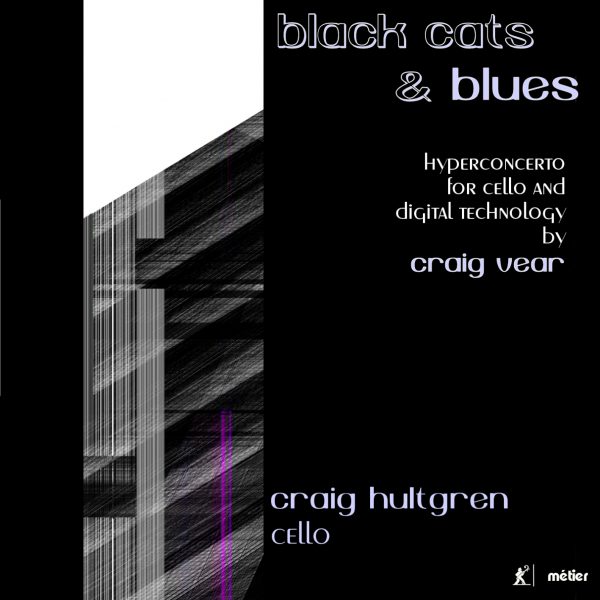Fanfare
Inspired by Boris Vian’s 1949 collection of 10 short stories Blues for a Black Cat (and cast in 10 titled movements), Craig Vear’s Black Cats and Blues aims to provide a spate, hybrid performance environment for each story/movement; it’s a pity that the video element is withheld from the compact disc.
So it is that the first movement, “The Plumber,” finds the cello in virtuoso form as he constructs an imaginary plumbing system using the metaphors of joints, bends, and so on. It is meant to be claustrophobic: dedicated to Marcel Duchamp (he of toiletary art installation), it is headed by a quote: “In any case, if I could just get my hands on the dirty son of a bitch with his fat kangaroo ass. who botched this goddamn whorehouse of a shit installation.” Cellist Craig Hultgren is clearly at home in the dissonant, angular music.
A far more fractured soundworld is evoked by “Pins and Needles,” with its quote “I have had enough of this war—and I’m getting pins and needles.” Describing a soldier standing on a landmine, it is apparently accompanied by a video of a soldier “pirouetting on one foot while he tries to write his letter.” There is a sense of space and desolation to the music, Craig Hultgren’s expressive cello plaintive and touching. This is the first time in the piece we hear this aspect of Hultgren’s playing.
The second part was dedicated to Rene Clair; the movement entitled Blues for a Black Cat is dedicated to Gavin Bryars. Here, the images are surely essential to a full experience: The story is that of two lovers walking in Paris who are distracted by a miaowing cat underneath the pavement. The video is apparently of super-8 images of lovers in Paris in the 1980s, its procession of images controlled by the cellist’s bowing motion. Notes from the cellist’s discourse are isolated and pro¬longed by the electronics. The result is a plaintive nocturne, with the cello in its highest registers presumably indicating the cat. The created simultaneities are at times stunningly beautiful.
Dedicated to Max Ernst, “Cancer” refers to the disease, not the star sign; there is a deliberate attempt to depict in sound the cancer’s metastasis (spread) across the body. Four embryo cells move unpredictably in the video that goes alongside this music. Electronic sounds create a real sense of unrest. Emerging from that movement is “Dead Fish” (dedicated to John Milton Cage). Performance instructions here are close to that of “The Plumber”; the idea here though is that the cellist feeds his environment as if it were a living thing, and the environment reacts to that feeding (depending on what is being “fed,” the environment may approve or disapprove of the sounds). There is a real per¬former choice here, as the cellist has to steer away from either starving or overfeeding in a sort of contemporary music Tamagotchi. Interestingly, there is a sort of damaged beauty to the movement that is most compelling.
I wonder how many pieces of serious contemporary music have been dedicated to Groucho Marx? The sixth movement, “Journey to Khonostrov,” is a dialogue between reciter (here the cellist, who is listed merely as “performer” in the booklet inside cover, but as cellist elsewhere) and cello, with a subsidiary dialogue between arco and pizzicato playing styles. Quite a shift from that lightness to the depth of sound (both in terms of texture and pitch) for “Blue Fairy Tale,” a tale of obsession with a woman’s beauty. Lines move in sampled counterpoint and evaporate, responding to the movement’s accompanying quote: “Her hair always imprisoned the sun.” Simple repeated gestures fire the impression of an “adultized” fairy tale; the first 30 seconds of solo cello is fed back to the live performer to create what is effectively a low string ensemble. The music elevates itself as the piece progresses, lightening, but the process is cut short in mid-flow and interrupted by the ambient chatter of the opening of “Fog.” The chatter is presumably that of the Paris cafe where, in this imagined scenario, the cellist as busker is asked to entertain, or at least to capture the attention of. (The audience ignores the music, in fact; in the event, he fails and plays to the traffic.)
Dedicated to James Joyce, “Good Students” tackles the injustices of the world. The idea is to transform the cello into a “sonic weapon with which to avenge the injustices”; the sound is indeed strident in the extreme, the virtuosity seemingly superhuman, the impression that of unremitting anger.
The frozen sounds of the final panel, “One-Way Street,” are reflected by the method of generating the music: The cellist is asked to choose music “like following crystal strata in a rock formation.” The cellist’s musings are cross-filtered against the sound of ice cracking in a stream. The video of bright and vivid colors against a gray space seems to be the perfect accompaniment to the music, and how wonderful it would be to experience this.
A meeting of Anglo-American artists (Vear is Professor of Digital Performance and Music at the Institute of Creative Technologies at De Montfort University, UK, while Craig Hultgren, after 30 years with the Alabama Symphony, is now a resident of Decorah, Iowa, where he is the “farmer-cellist” according to his biography), this is a fabulously inventive score presented with real flair and performed with the utmost virtuosity.
@divineartrecordingsgroup
A First Inversion Company
Registered Office:
176-178 Pontefract Road, Cudworth, Barnsley S72 8BE
+44 1226 596703
Fort Worth, TX 76110
+1.682.233.4978










![Listen to the full suite of Marcel Dupré’s Variations Sur un Noël, Op. 20 from Alexander Ffinch’s #Expectations release today! listn.fm/expectations [in bio]](https://scontent-lax7-1.cdninstagram.com/v/t51.71878-15/588904367_2327488161082898_8709236950834211856_n.jpg?stp=dst-jpg_e35_tt6&_nc_cat=105&ccb=7-5&_nc_sid=18de74&efg=eyJlZmdfdGFnIjoiQ0xJUFMuYmVzdF9pbWFnZV91cmxnZW4uQzMifQ%3D%3D&_nc_ohc=b5g9hiAMsPAQ7kNvwEs1WrM&_nc_oc=Adkco5XoMVHafQwLbo39W6ZUp6xE8gctlt0u-ZDH8eAJ3vYkTI5JMUg8_ghG_WAL3vA&_nc_zt=23&_nc_ht=scontent-lax7-1.cdninstagram.com&edm=ANo9K5cEAAAA&_nc_gid=6qUQt7MIm5XXZAz_AsA6Gg&oh=00_Afl1bI-3UBvG9edkzaeN_Kd9w3gj5qeb9lSbG_t_1-B0DA&oe=695093AA)

![“the ‘Manteca’ Paraphrase – a rare foray into the two-piano medium but here played double-tracked – exudes a panache of which Dizzy Gillespie would surely have approved.… [a] recital well worth investigating.” —Gramophone Magazine with high praise for Ophelia Gordon's debut release, Kapustin: Between the Lines!](https://scontent-lax3-1.cdninstagram.com/v/t51.82787-15/598796470_18303255136283342_540941604740887837_n.jpg?stp=dst-jpg_e35_tt6&_nc_cat=108&ccb=7-5&_nc_sid=18de74&efg=eyJlZmdfdGFnIjoiRkVFRC5iZXN0X2ltYWdlX3VybGdlbi5DMyJ9&_nc_ohc=qJeKeEK7ScQQ7kNvwG6nlC3&_nc_oc=Adn8DiM4lHbvoWp1BQJkc0suFSGIn3fxeYlEKxrV_2a8WAzXo7cmoD9Cir2sqTvLcD0&_nc_zt=23&_nc_ht=scontent-lax3-1.cdninstagram.com&edm=ANo9K5cEAAAA&_nc_gid=6qUQt7MIm5XXZAz_AsA6Gg&oh=00_Afk4E75miban_jp7qHAOoRidBlpmKme_r2gKqroCripV8w&oe=6950A644)